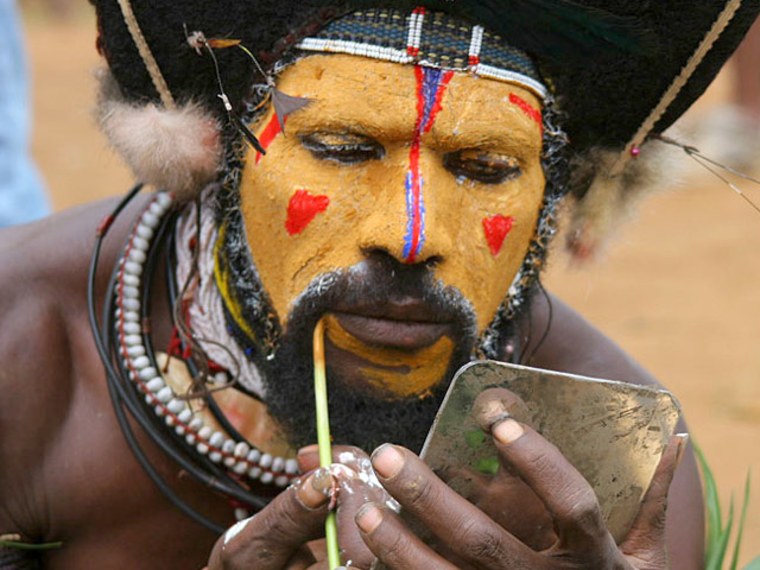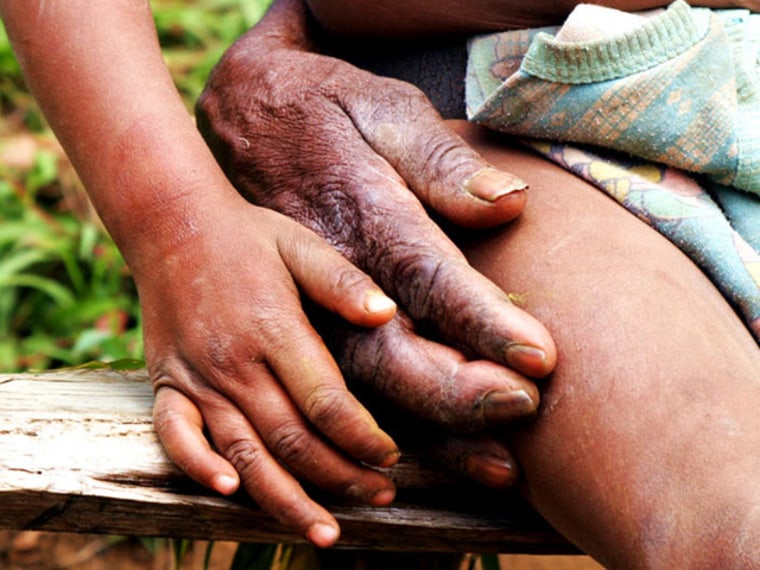After several days of digitally reproducing their environment and family, of capturing things and scenes these Hulis deem beautiful, clan leader Paul Poki asks if we want to see the most beautiful spectacle they know. He wants to throw a sing-sing for us, and have his family photograph the event.
So, as the morning light clarifies the land we gather on a ridge overlooking a barrier of steep, green mountains, where members of Tigibi village prepare for a sing-sing.
It is a long process, about two hours worth of primping and preening. No man can dress himself… it’s a group affair, with each helping the others. First the men carefully fit their tight wire-like wigs, adjusting the opossum-fur rim. They rub ginger into the matted hair, lave it with water, tease it with sticks into its final shape. Each wig takes about 18 months to grow, or harvest, and is colored with pork fat, charcoal and red clay. I push my finger into one: it feels like coarse felt, and resembles a seafarer’s bicorn hat of 18th-century sea captains.
The what and why of wigs
The wigs exist primarily as pin cushions for the various fantastic feathers. They stick the wig with frilly plumes of sulfur crested cockatoos, yellow billed lorikeets, tiger parrots and several birds of paradise. An everlasting daisy fronts the wig like a knowing eye.
They then push quills and pencils of black palm through the septa of their noses. They circle their necks with colorful bead and cowrie necklaces that hold pigs’ tusks and kena shells, the prized half-moon cut from gold-lip mother-of-pearl that was once the trade currency of the land. They sport tight arm and leg bands of fresh pandanus leaves, and an apron made from tree bark. The serrated beak of a hornbill, traded from the lowlands, hangs from the back of the neck; on the rattan cane belt is the dagger fashioned from the thigh of a cassowary.

Then, using hand mirrors where they once used glassy water, they use bamboo brushes to painstakingly apply their mask-like make-up, first a white base to their faces, and on top a vivid yellow clay called ambua. Then they complete the transformation with blood-red streaks from a local berry.
In the midst of this orgy of make-up a very old man scuffles by the players and sits down on a log. He has the weary look of a man who has kept company with ghosts. I sit next to him, and with Paul as a translator ask him some questions. He is Joloma Angape, the oldest living Huli, who estimates his age at 90.
The oldest Huli
He has come, he says, to judge the sing-sing dancers, as he has done for decades. He goes on to say that he was in the valley when the first white men emerged from over the mountains in 1935. “We never knew there were other people in other countries,” he relates. At first they thought the visitors were spirits, perhaps the souls of Hulis who had passed away and returned, and as the apparitions approached the Huli scrabbled away like wild pigs.
Sitting on this edge of memory, Joloma recollects the white men as being generous, as they brought salt, matches, eggs and razor blades, and gave them steel axes to replace their stone models. And they brought guns, and to show their power they shot dead several Hulis.
Joloma recalls the time with attachment. He says the white men “tamed us,” and goes on to elaborate: Now I am free, and happy the white people have come.”
It sounds a bit too politic from a wizened New Guinean in the company of an Anglo stranger, and as I look about at the dancers slathering their dark bodies in tigaso tree oil I see a sea of scars, all from pay-back battles in what they call Highlands Football. Some traditions die hard.
Bird chatter gives way to a funereal drum beat, and the dance begins, a thudding ballet of dazzling pigments and glistening muscles. The warriors line up in parallel and chant and thump their snake-skin drums, and do a coordinated bouncing stomp on the hard scrabble, an exuberant bop that imitates a bird of paradise in a courting dance. Paul’s family circle around the action like sports photographers, shooting the extravaganza from every angle. James the teen plays with the video function of the HP Photosmart R707 and makes several short videos of the wild colors and mean streaks, a Scorsese in the making.
End of the dance
As the show is winding down Didrik counts the number of images captured by Paul’s family: 445. They are jubilant, and call for group photos all around. But then I get a call on my satellite phone. My mother, a lifelong amateur photographer, with drawers and drawers stuffed with photos of her family, has passed away. Paul and Mathar can tell from my face, and come over to comfort me. And the dancers do a last dance for her departed spirit.
The rich blue sky bends towards the sultry green infinity of the surrounding hills, a place where time has stood still. For us it is time now to go. I will head back and sift through the piles of photographs I am so glad my mother took over the years, a whole lifetime of memories. And I’m glad Paul and his family now have photos, too, so they can remember.
As we’re heading out Paul takes a photograph of Joloma, the old man. He then turns and says, “All the Hulis who first met the Europeans are gone now. They are underground, and their bones have turned to soil. Joloma is our last connection to the past. If we had cameras like these then we would have a better way to know what the time before was like.”

And now they will. If beauty is eternity gazing at itself in the mirror, and pictures can capture pieces of eternity, then the Huli will now forever know the convulsive beauty of their living culture and vanishing past. And for that, all on this little hill in the fine heart of the island of New Guinea are thankful.
Great Escapes is exploring Papua New Guinea in search of the Digital Village, filing daily dispatches along the way. If you have a question or comment, mail us at greatescapes@msnbc.com.